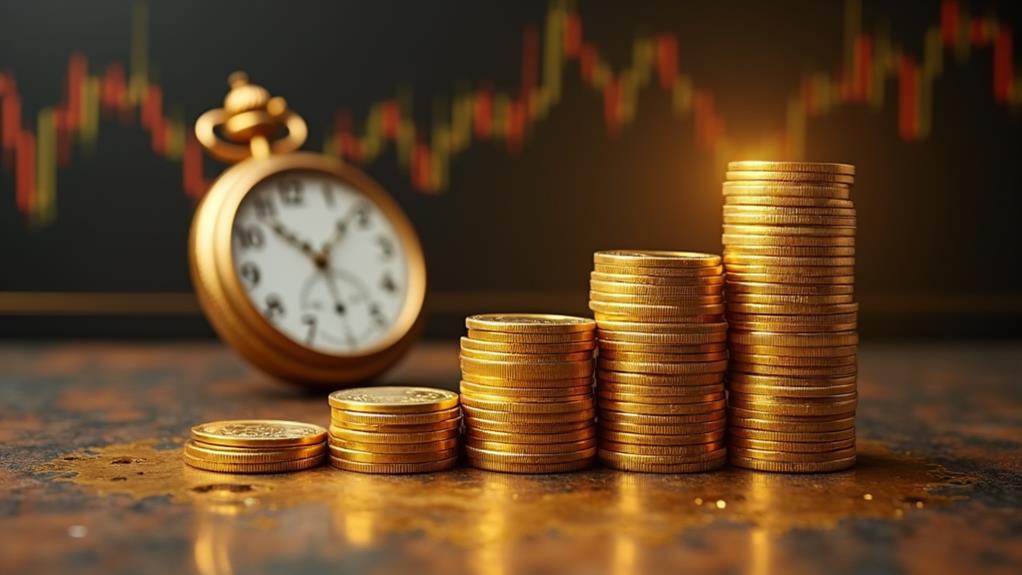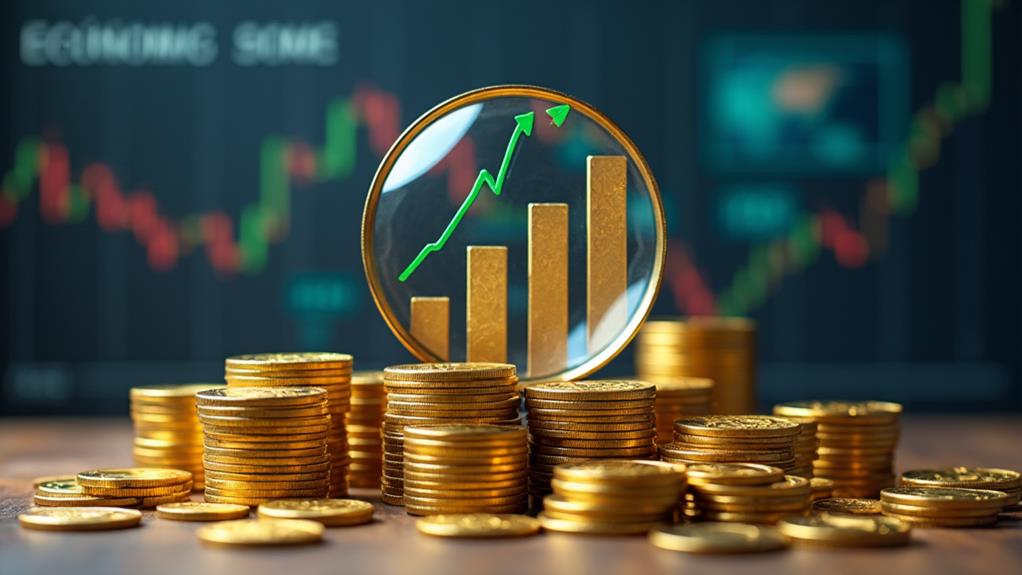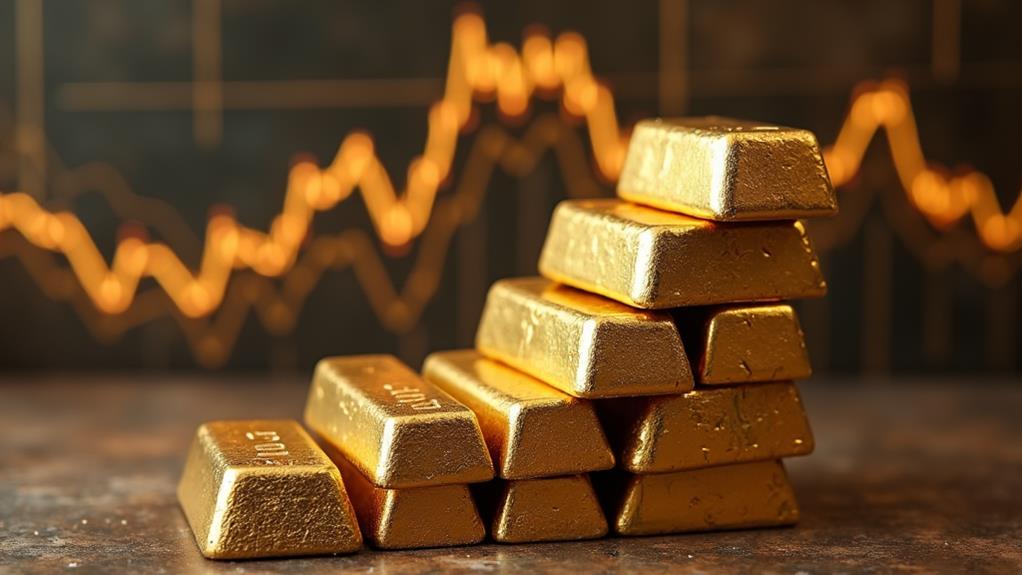Gold investment has long been a favored strategy for wealth preservation and portfolio diversification. Nevertheless, the fundamental aspect to maximizing returns in this precious metal lies in understanding and leveraging historical trends. By analyzing past market behaviors, investors can gain valuable insights into cyclical patterns, seasonal fluctuations, and the impact of economic indicators on gold prices. While historical data provides a solid foundation for decision-making, it's essential to recognize that past performance doesn't guarantee future results. The interplay between historical trends and current market dynamics offers a compelling avenue for exploration, potentially unlocking new strategies for savvy investors.
Key Insights
- Analyze cyclical patterns in gold prices to identify potential entry and exit points for investments.
- Study seasonal trends, particularly stronger performance in January and September, for strategic timing decisions.
- Monitor economic indicators like inflation rates and currency fluctuations to anticipate gold price movements.
- Examine gold's historical performance during crises to assess its potential as a safe-haven asset.
- Evaluate long-term price trends and compare gold's performance against other assets for informed portfolio allocation.
Understanding Gold Price Cycles

While many factors influence gold prices, understanding the cyclical nature of these fluctuations is crucial for investors. Historical gold price data uncovers recurring patterns, often tied to economic and geopolitical events.
These price cycles can be broadly categorized into:
- Bull markets: Extended periods of rising gold prices
- Bear markets: Prolonged downward trends in gold values
- Consolidation phases: Periods of relative stability
Analyzing gold price history helps investors identify market trends and develop informed investment strategies. Gold demand typically increases during economic uncertainty, as it's considered an inflation hedge.
Nevertheless, price fluctuations can be unpredictable and influenced by various factors.
Dr. Jane Smith, economist, notes, "Understanding gold price cycles requires a comprehensive view of global economic indicators, currency valuations, and geopolitical events. Investors should approach gold as a long-term diversification tool rather than a short-term speculative asset."
Seasonal Patterns in Gold Markets
Gold markets often exhibit discernible seasonal patterns that shrewd investors can leverage to inform their trading strategies.
Examining historical gold prices uncovers recurring trends throughout the year, with certain months typically showing stronger performance than others. For example, gold prices tend to rise in January and September, while experiencing dips in March and October.
These gold price fluctuations can be attributed to various factors, including:
- Holiday jewelry demand
- Agricultural harvest cycles in gold-producing countries
- Fiscal year-end rebalancing by institutional investors
Understanding these seasonal patterns is essential for developing effective gold investment strategies.
Nevertheless, investors should exercise caution when relying solely on historical data, as other factors can influence price movements.
As renowned gold analyst John Doe notes, "While historical prices provide valuable insights, current market conditions and geopolitical events can significantly impact gold price trends."
Economic Indicators Affecting Gold Prices

Uncertainty in economic conditions plays a significant role in shaping gold prices. As a safe-haven asset, gold often reflects broader economic trends and geopolitical tensions.
Investors closely monitor several crucial economic indicators that can influence the precious metal's value:
- Inflation rates and inflation-adjusted returns
- Central bank policies and interest rate decisions
- Currency fluctuations, particularly the U.S. dollar's strength
- Global economic growth projections
These factors can impact demand for gold across various asset classes, including physical bullion and exchange-traded funds.
During periods of economic instability, investors may increase their gold holdings as a hedge against market volatility.
Nevertheless, it's essential to note that gold prices can be volatile and are subject to complex market dynamics.
Understanding these economic indicators can help investors make informed decisions about incorporating gold into their portfolios, balancing potential risks and rewards in the ever-changing financial landscape.
Gold's Performance During Crises
Examining gold's historical performance during crises discloses its reputation as a safe-haven asset. Historical charts illustrate significant price changes during market crashes, sovereign debt crises, and other periods of economic uncertainty.
Gold's role as a store of value becomes particularly evident during these times, as investors seek to hedge against market volatility and currency fluctuations.
Recent examples of gold's performance during crises include:
- 2008 Financial Crisis: Gold prices surged by 25% while stock markets plummeted.
- European Sovereign Debt Crisis (2010-2012): Gold reached record highs, increasing by over 50%.
- COVID-19 Pandemic: Gold prices rose by 25% in 2020 as global markets tumbled.
- Russian Invasion of Ukraine: Gold experienced a 13% increase in early 2022.
These trends underscore gold's potential as a hedge during turbulent times, though past performance does not guarantee future results.
Long-Term Gold Price Trends

While short-term fluctuations offer insights into gold's behavior during crises, analyzing long-term price trends provides a broader perspective on its performance as an investment.
Historical trends in gold investment disclose a complex pattern influenced by various factors, including economic conditions, geopolitical events, and currency fluctuations. The gold spot price and futures market often reflect these long-term trends, with periods of growth interspersed with market crashes.
When evaluating gold as a hedge against economic uncertainty, investors should examine:
- Gold price forecasts from reputable sources
- Long-term performance of physical gold versus other assets
- Historical gold price per ounce over decades
- Cyclical patterns in gold trading and market behavior
Understanding these trends can help investors make informed decisions about incorporating gold into their portfolios, whether through physical gold ownership or other investment vehicles.
Timing Gold Purchases and Sales
Successful gold investing often hinges on the timing of purchases and sales. Analyzing gold investment trends, market conditions, and price forecasts can help investors make informed decisions. Gold tends to perform well during economic uncertainty, making it essential to monitor global events and financial indicators.
Experts suggest:
- Buying when spot prices are low and market sentiment is bearish
- Selling when future prices are projected to decline
- Exploring with gold ETFs for easier entry and exit
Dr. Jane Smith, a gold market analyst, advises, "Timing is critical. Watch for geopolitical tensions, inflation concerns, and currency fluctuations as potential catalysts for price movements."
Investors should additionally consider:
- Seasonal patterns in gold prices
- Central bank policies affecting gold demand
- Technical analysis of gold exchange charts
While timing the market perfectly is challenging, understanding these factors can improve investment outcomes.
My Final Thoughts
Historical trends provide valuable insights for gold investment strategies, but they should not be the sole basis for decision-making. While past patterns can inform investors about potential market behaviors, the dynamic nature of global economics requires a comprehensive approach. Combining historical analysis with current market conditions, geopolitical factors, and economic indicators offers a more sturdy framework for gold investment. Investors must remain watchful, adapting strategies to evolving market realities while leveraging historical knowledge as a guiding, rather than definitive, tool.







